By Nippon Pulse America
Have you ever picked up a motor and discovered it had a few more wires then you were expecting? If so, it was likely a step motor. Step motors are commonly used in a number of products, from wrist watches to printers, IV pumps to gas pumps. They are also found in machine tools, process control systems, tape and disk drive systems, and programmable controllers.
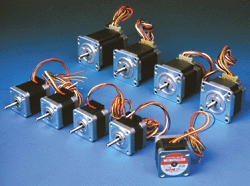
Common permanent-magnet (PM) step motors are the Tin Can or claw-tooth type. They operate on the reaction between a permanent-magnet rotor and an electromagnetic field.
As common as step motors are, however, there is much confusion about the differences between Unipolar and Bipolar step motors, and how Constant Current and Constant Voltage step motor drives work.
This 2-part series will cover the most important steps of troubleshooting any step motor system. It will include an overview of step motors — what they are and how they work, and how to troubleshoot them. The second article will also cover the electronics needed to make a step motor run, and provide more information on troubleshooting.
The basics
A step or stepping motor converts electronic pulses into mechanical movement. Each electronic pulse “step” causes the shaft to rotate a certain number of degrees (step angle). Thus, a step motor can operate in an open loop application where it will move a certain distance at a certain speed without the need for feedback.
The step motor can maintain the holding torque indefinitely when the rotor is stopped without burning up the motor windings. When a step motor has a steady dc signal applied to one stator winding, the rotor will overcome the residual torque and line up with that stator field. The holding torque is the amount of torque required to move the rotor one full step with the stator energized.

A step motor converts electronic pulses into mechanical movement. Each pulse “step” causes the shaft to rotate a certain number of degrees (step angle), enabling open loop operation.
When no power is applied to the windings, a small magnetic force develops between the permanent magnet and the stator. This magnetic force is called the residual, or detent torque. It can be noticed by turning a step motor by hand and is generally about one-tenth of the holding torque.
In a typical one-phase step sequence for a two phase motor, phase A of a two-phase stator is energized (Step 1). This magnetically locks the rotor in the position shown, because unlike poles attract. When phase A is turned off and phase B is turned on, the rotor rotates 90° clockwise. In Step 3, phase B is turned off and phase A is turned on but with the polarity reversed from Step 1. This causes another 90° rotation. In Step 4, phase A is turned off and phase B is turned on, with polarity reversed from Step 2. Repeating this sequence causes the rotor to rotate clockwise in 90° steps.
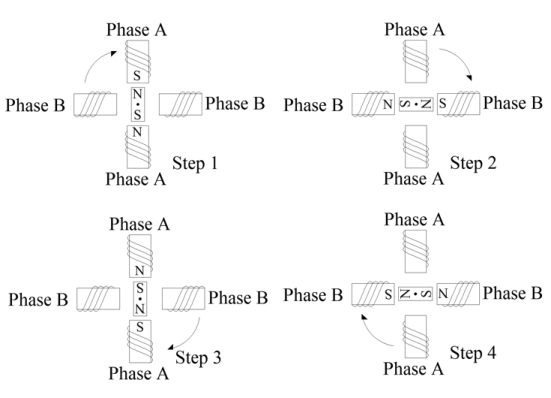
Here is a typical step sequence for a two phase motor.
There are three main types of step motors: permanent-magnet (PM), variable reluctance (VR) and hybrid.
The permanent-magnet (PM) step motor operates on the reaction between a permanent-magnet rotor and an electromagnetic field. One of the most common PM motors are the Tin Can or claw-tooth type. In tin can steppers, the rotor shaft is surrounded by a magnet with radially opposing poles. It has no teeth. The stator is a series of poles with wound wire coils. Because of the magnet, the rotor will resist movement even when the motor is not energized.
Permanent magnet step motors are used in low-cost, low-power applications. The bill feeder inside vending machines is driven by a permanent magnet step motor.
The variable-reluctance (VR) step motor differs from the PM stepper in that it has no permanent-magnet rotor and no residual torque to hold the rotor at one position when turned off. This type of motor operates on the principle of minimizing the reluctance along the path of the applied magnetic field. One of the first uses for variable-reluctance step motors was to move the direction indicator of torpedo tubes and guns on British warships in the 1920’s. Shortly thereafter, they were used by the US Navy for a similar purpose.
The hybrid step motor consists of two pieces of soft iron, as well as an axially magnetized, round rotor. It’s called a hybrid because the motor operates under the combined principles of the permanent magnet and variable-reluctance step motors.
The stator core structure of a hybrid motor is essentially the same as its VR counterpart. The main difference is that in the VR motor, only one of the two coils of one phase is wound on one pole, while a typical hybrid motor will have coils of two different phases wound on the same pole.
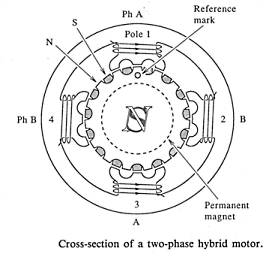
In this cross section of a two-phase hybrid motor, each pole is covered with uniformly spaced teeth that are misaligned with each other by a half-tooth pitch. The interaction of the magnetic field of the permanent magnet and the magnetic field produced by the stator create torque.
The two coils at a pole are wound in a configuration known as a bifilar connection. Each pole of a hybrid motor is covered with uniformly spaced teeth made of soft steel. The teeth on the two sections of each pole are misaligned with each other by a half-tooth pitch. Torque is created in the hybrid motor by the interaction of the magnetic field of the permanent magnet and the magnetic field produced by the stator. Most hybrid steppers are NEMA size motors. The windings for steppers come in two types: Bipolar and Unipolar. There are a number of advantages to each type of winding.
The two-phase stepping sequence described earlier uses a “bipolar coil winding.” Each phase consists of a single winding. It is referred to as a bipolar winding because the current flow on the coils is reversed. By reversing the current in the windings, electromagnetic polarity is reversed.
The unipolar winding is sometimes called a four-phase stepper. It consists of two windings on a pole connected in such a way that when one winding is energized a magnetic north pole is created; when the other winding is energized, a south pole is created. It is referred to as a unipolar because the electrical polarity, or current flow, from the drive to the coils is never reversed.
What can go wrong with step motors
In general, there are four things that can go wrong with a motor: They burn up, the brushes go bad, the bearings go bad, or a technician breaks them.
They burn up. An important characteristic of the step motor is that it can maintain the holding torque indefinitely when the rotor is stopped. If a step motor stalls out, it is unlikely that it will burn up as with most ac and dc motors. If the motor does burn up it indicates a driver problem. (We will explore why this is the case in the next article.) Just replacing the motor will cause the motor to burn up again. This is not a common problem with step motors unless there is a bad driver.

Example of a bipolar winding and example of a unipolar winding. In a bipolar winding the current flow on the coils is reversed, which reverses electromagnetic polarity. In a unipolar winding, the electrical polarity, or current flow, is never reversed, hence the name unipolar.
The brushes go bad. There are no brushes in a stepper motor. Therefore, this will never be a cause of failure.
The bearings go bad. The cooler the motor stays, the longer the bearings will last. At times, however, the bearings will go bad. Still, this is not a common problem. The bearings in most inexpensive motors are rated at 3000 hours or more, and most high-end quality motors are rated at 90,000 to 100,000 hours.
The technician breaks them. This is the most common cause of failure for step motors. When working with these devices, be careful with them. They do not need to be handled like fine china but don’t try to fix one with a hammer. Most inexpensive motors use glue to hold the shaft to the rotor, and most quality steppers will use grooving along with adhesive.
To test the motor, first use an ohmmeter. It will indicate if a winding is burnt up and what type of step motor you have, usually a bipolar or unipolar.
A bipolar will always have four leads. A unipolar will have five or six leads. If five leads, the two common wires are connected. A few motors will have eight leads; these motors can be wired as either unipolar or bipolar.
Using the ohmmeter, check the resistance of the windings. On a bipolar the resistance for both windings should be the same in both directions. In a unipolar winding, the resistance from each phase to com should be the same in both directions. After you have checked the motor with the ohmmeter, you can use a 9V battery to step the motor through its paces. This will confirm the motor windings are good. You can use the charts in Figure 9 for assistance.
You can turn the motor by hand while listening for bad bearings. All PM and hybrid step motors will have some detent torque. PM will have more than the hybrid steppers. If the leads of the step motor are touching, the detent torque will be greatly exaggerated. Be careful! Some technicians have falsely linked this to bad bearings. If the bearings are bad, there will usually be extra axial play in the motor. If possible, check against a known good motor.
When replacing a motor, many wonder about the color code for the wires. Remember the windings make up an electromagnet. As long as you have the windings grouped correctly (Phase 1 and 3 together and Phase 2 and 4 together) the worst that will happen when you go to run the motor is that it will run backwards. To correct, just swap one set of phases (1 and 3 or 2 and 4).

A few step motors will have eight leads; these motors can be wired as either unipolar or bipolar.
Next time we will explore the differences between Bipolar vs. Unipolar windings and how Constant Current and Constant Voltage types of stepper motor drives work. And answer the question, why do I use a 5V motor when I have a 24V supply? DW
Nippon Pulse America
www.nipponpulse.com
You may also like:
Filed Under: Motion control • motor controls, Motors • stepper



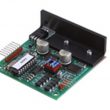

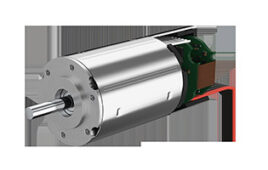
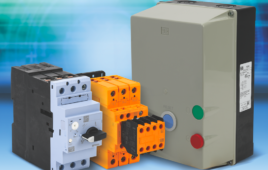

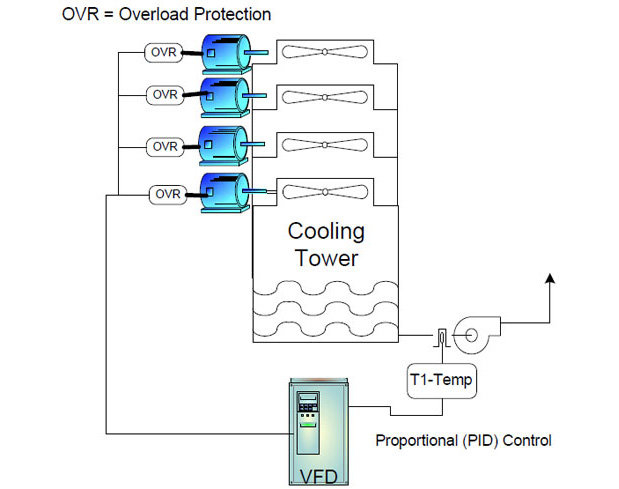
good guidelines
I have a stepper motor running and stopping at a specific region on the x axis